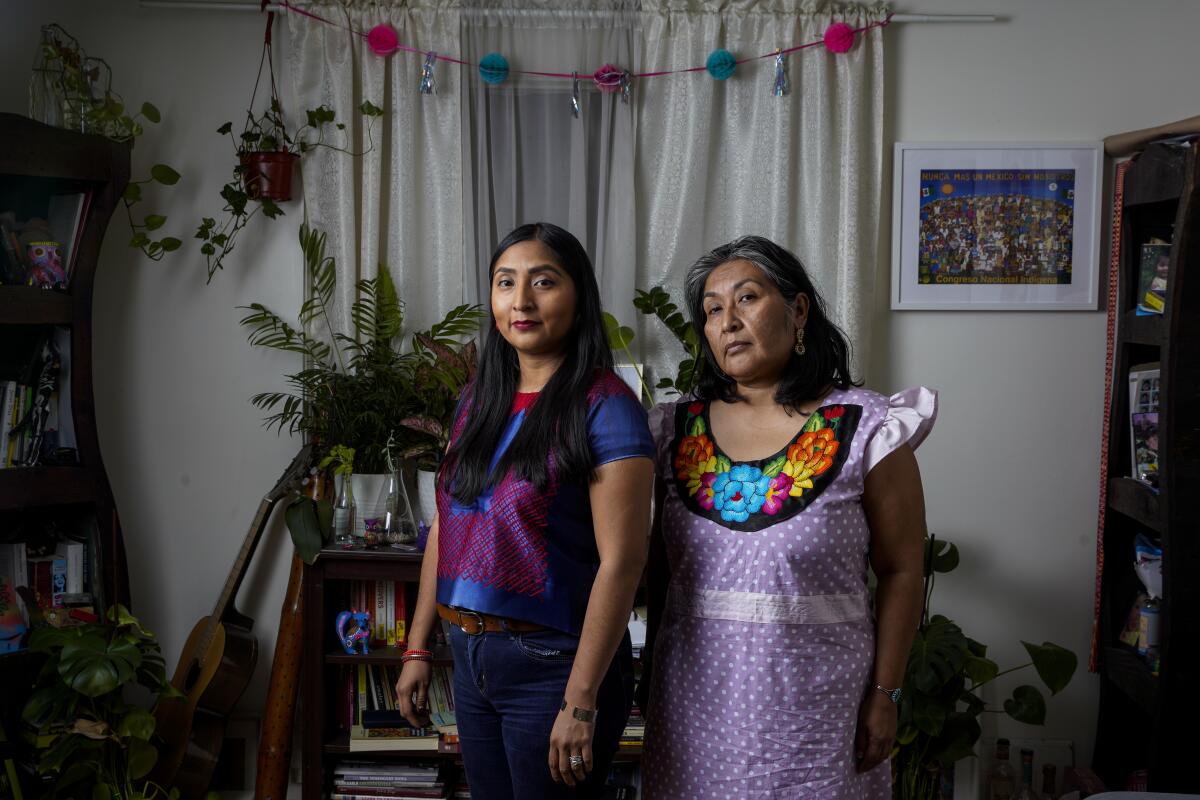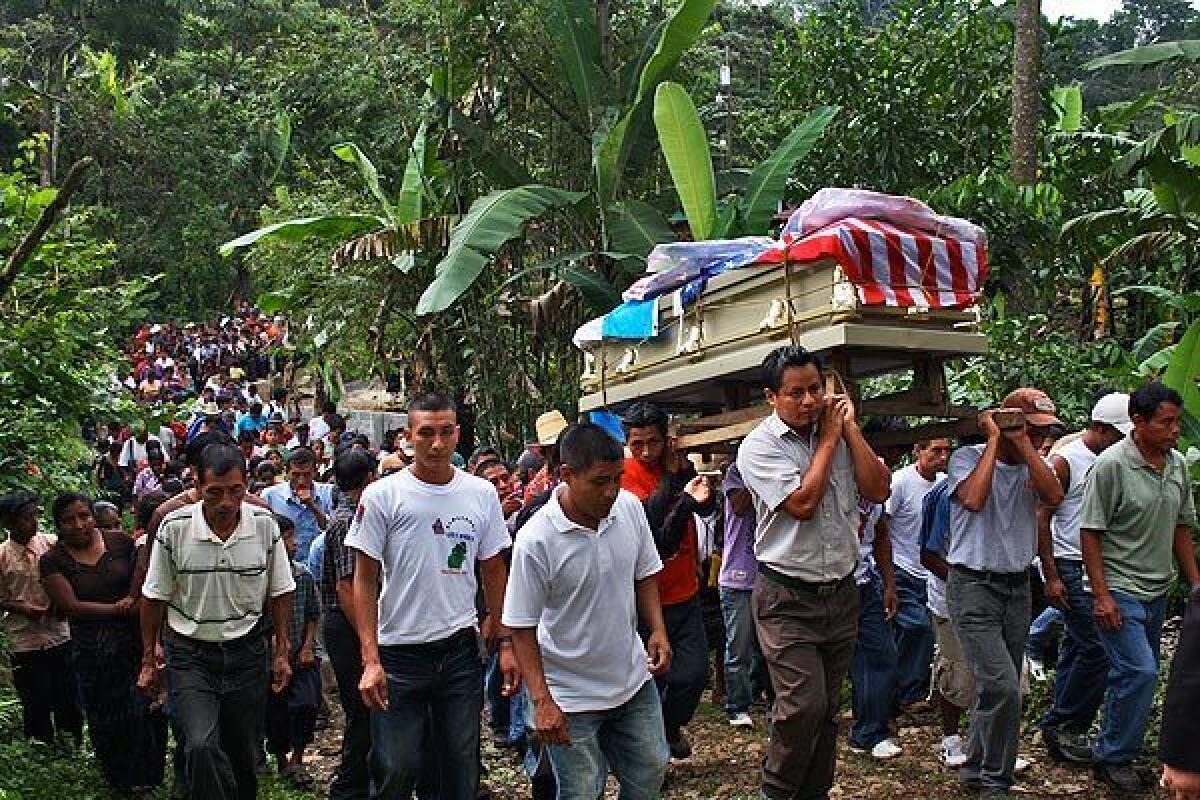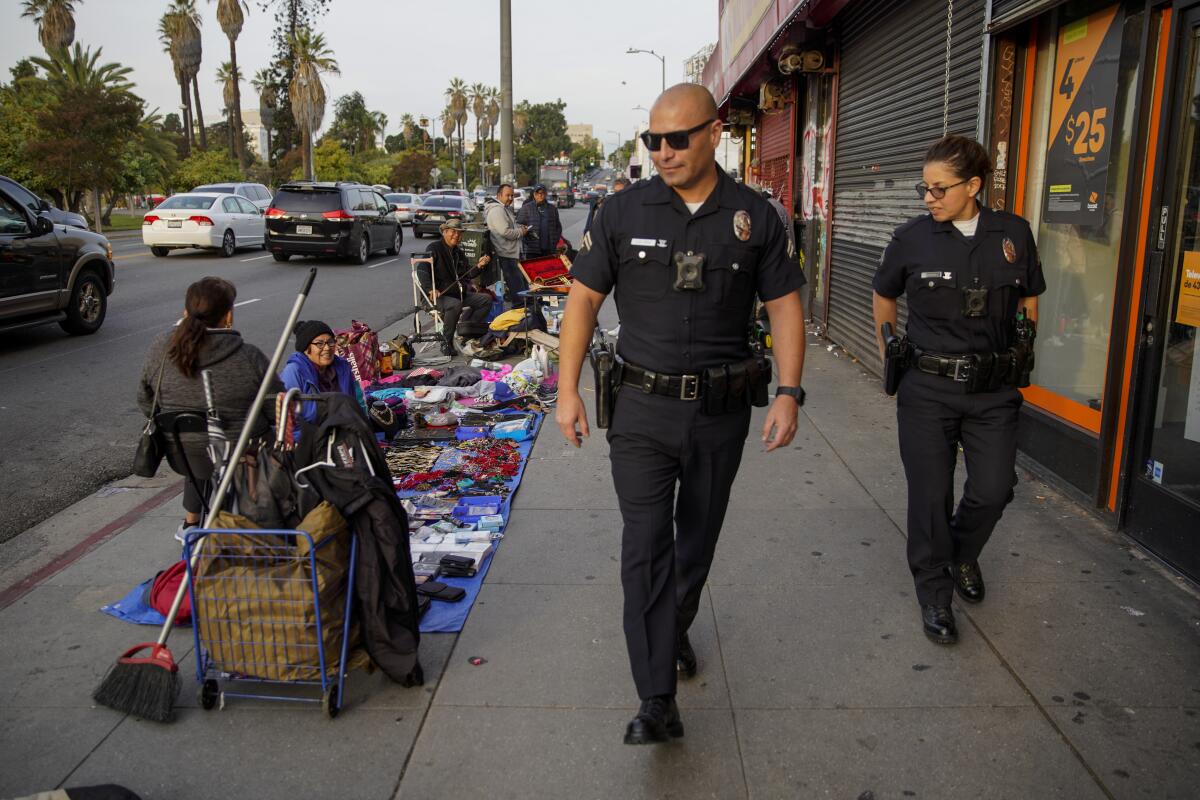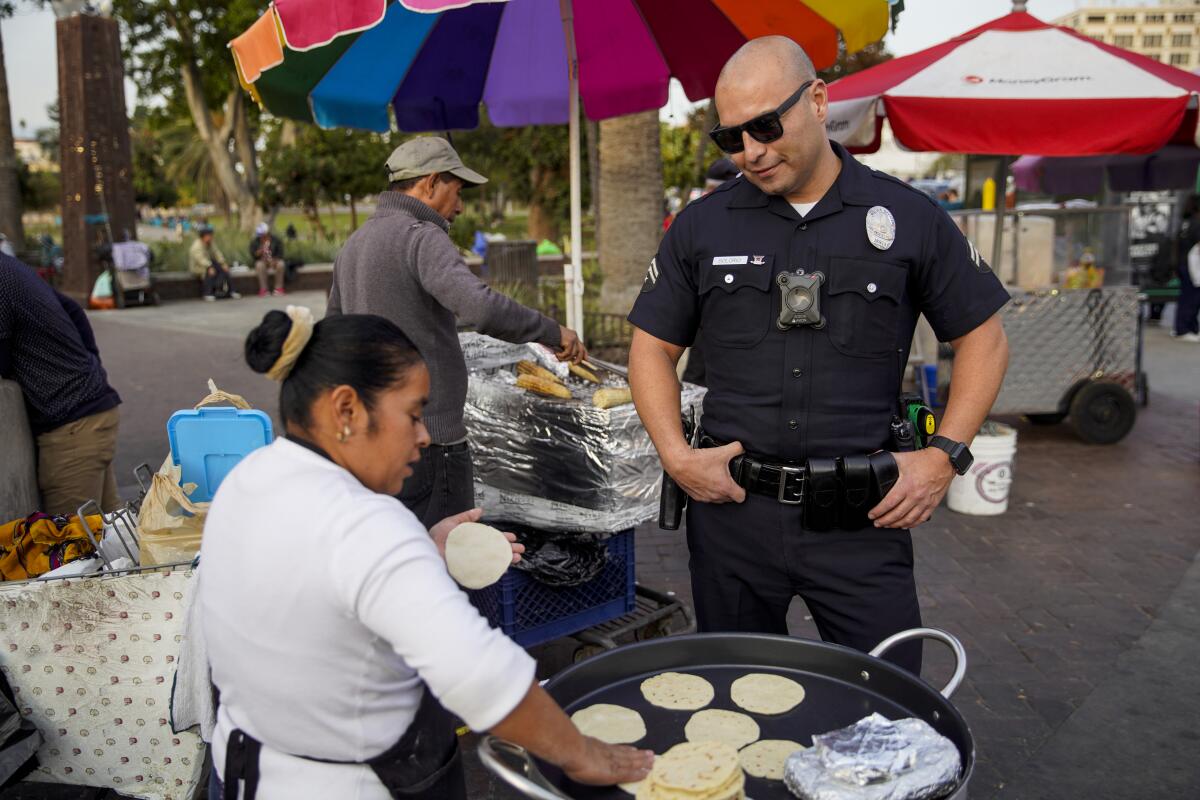Nine years after Guatemalan man’s shooting, LAPD officers get help to identify indigenous languages

- Share via
The officer at the front desk of the LAPD’s Rampart station couldn’t understand the language the distraught mother and daughter were speaking. So he called over the intercom for help.
As she listened to the mother speak, Officer Lucia McKenzie identified a familiar rhythm.
“I said, ‘K’iche’?’ and she got super happy, a big smile on her face,” McKenzie said.
K’iche’, spoken by Guatemalan Mayas, is one of many indigenous languages common in Los Angeles’ immigrant communities. Later this month, Los Angeles Police Department officers will begin carrying pocket cards that can help them identify an indigenous language and, if necessary, call an interpreter. The city is home to Mexicans who speak languages such as Zapotec, Mixtec and Triqui, as well as Guatemalan Mayas who speak languages like K’iche’ and Q’anjob’al.
“Unfortunately, we always made the assumption that they were all Mexican, they were all Spanish-speaking and we could get the message to them about building trust, about working with us, in Spanish,” said Al Labrada, a South Bureau commander for the LAPD. “We hadn’t taken the time to identify the key leaders in the community that could help us bridge that gap.”
The need for such outreach became acutely clear in the wake of a 2010 police shooting.
On a September afternoon that year near the intersection of 6th Street and Union Avenue in Westlake, LAPD officers encountered Manuel Jaminez Xum, a 37-year-old Guatemalan day laborer who allegedly was drunk and threatening passersby with a knife. Authorities said that police repeatedly ordered him — in English and Spanish — to drop the weapon, but that Jaminez raised the knife over his head and moved toward one officer, who opened fire. Jaminez died at the scene.
The shooting, which later was declared justified by LAPD’s oversight body, incited violent protests in the heavily immigrant neighborhood. The fact that Jaminez spoke K’iche’ underscored that there are those in L.A.’s Mexican and Central American immigrant communities who may not be fluent in Spanish.
Shortly after, indigenous Mexican community leaders began organizing training for officers in the LAPD — a department whose force is about half Latino.
More than 20% of Mexico’s population considers itself indigenous; in Guatemala, more than 40% of residents have been classified as Maya.
There is no census count on the number of indigenous people living in Los Angeles. The languages they speak can be as different from Spanish as Chinese is from English, and can contain dozens of variants. There are 32 Mayan languages, for example, said Danny Law, a linguist at the University of Texas at Austin who has participated in the cultural awareness training.
“Just being aware of that possibility goes a long way,” Law said. “A police officer might get the impression the person they are talking to is being uncooperative intentionally.”

Back at the Rampart station that day about a year ago, McKenzie called Odilia Romero, a Oaxacan community leader she had worked with to organize the cultural awareness trainings. Romero helps run the Binational Front of Indigenous Organizations, a group that promotes the rights of indigenous people and has a network of interpreters. She connected the upset mother to an interpreter who spoke K’iche’.
Soon after, the station had a gang-involved battery case that detectives could follow up on.
“This person left at peace,” McKenzie said. “Normally their voices aren’t heard — they make the perfect victims.”
Advocates warn of mistakes that can occur when those who speak little Spanish are pressed to communicate with a bilingual officer.
“If the first responders — like the LAPD, the Fire Department — don’t know that there’s language diversity, that there’s this group of people, then a lot of things get lost,” Romero said. “If someone is a victim of domestic violence, of a rape, [the perpetrator] can go free if they don’t have an interpreter.”

During the police training sessions, presenters discussed prejudice toward indigenous people within Latin American culture. Gaspar Rivera-Salgado, a labor studies professor at UCLA, told officers, including many from Mexico, that in 2012 the Oxnard School District banned the racial epithet Oaxaquita, or little Oaxacan.
Romero, who works as a Zapotec interpreter, developed friendships with officers. On a recent Sunday, she texted Adrian Gonzalez, a patrol captain in the LAPD’s Rampart Division, saying she heard that officers had swept through a Guatemalan street market and confiscated vendors’ equipment — a rumor he said was not accurate.
“Any time the community has issues, they’ll go directly to her because there’s trust,” Gonzalez said, “and she’ll reach out to me to debunk something.”
Labrada said officers don’t use indigenous interpreters regularly. In most cases, someone like a family member can help out. But in more complicated situations, officers may contact Romero. They can also request to use the LAPD’s phone interpretation service.
The pocket cards, which already exist for Korean and American Sign Language, should make things easier. Assuming that the indigenous person understands a little Spanish, an officer can ask a person in that language what town they are from and whether they speak one of the nine indigenous languages listed on the card, which also contains contact numbers for Romero’s organization.
The all-volunteer Binational Front of Indigenous Organizations has a network of about 150 indigenous interpreters in the U.S. For Mixe languages, they have to call a contact in Oaxaca.
“There’s a large community of Mixe in L.A., but we haven’t found someone that wants to take it on,” said Janet Martinez, Romero’s daughter, who has helped coordinate training.

Efforts also are underway in other California counties to improve relations between immigrant communities and law enforcement.
A soon-to-be published study by the nonprofit group California Rural Legal Assistance examined how indigenous Mexicans living in Kern County are affected when they do not have access to an interpreter during interactions with police. Many of the 200 indigenous residents surveyed reported communicating with a bilingual officer who spoke varying degrees of Spanish. For some residents this was sufficient, if they too were fluent in Spanish. But others could not effectively communicate with officers.
“A cop will ask questions in Spanish and the person will answer in Spanish, and then the cop won’t recognize they’ll have little Spanish fluency,” said study author Marisa Lundin.
One person surveyed, a Bakersfield resident named Austolia who speaks Mixtec and understands little Spanish, said that several months ago police crossed a fence surrounding her family’s property.
Austolia, who declined to share her full name because she fears repercussions from the police, had been outside watering the grass. She said she tried to ask the officers in her limited Spanish what was happening, but they didn’t respond.
Her daughter-in-law, who speaks English, came outside and was told the police had been searching for a stolen car.
“We were very scared because they didn’t say what they were looking for, and I have my grandchildren here,” Austolia said. “They had guns, they had rifles.”
Sgt. Nathan McCauley, a spokesman for the Bakersfield Police Department, said he had been unaware there was a Mexican indigenous community in the county.
“It sounds like an unfortunate circumstance,” he said of Austolia’s experience, adding that police can’t always stop and speak to residents during an active situation. “We would like to communicate with everyone we come into contact with.”
Police in Oxnard have partnered for years with the Mixteco/Indígena Community Organizing Project, a nonprofit that works with indigenous communities in Ventura and Santa Barbara counties.
Investigative Services Bureau Commander Sharon Giles said that as the relationship has developed, more indigenous residents are reporting crimes.
“We started seeing the volume of [applications for] U-visas increasing,” she said, referring to the visa for immigrant victims of crimes.

Back near the LAPD’s Westlake station, Mexican and Central American vendors lined Alvarado Street across from MacArthur Park on a recent afternoon.
Senior lead officer Robert Solorio chatted with various K’iche’ speakers in Spanish. He greeted a woman cooking tortillas at the entrance of the park who said she spoke K’iche’ — and a little Spanish. Before leaving, he pretended to warm his hands on her stove. She laughed.
“You’d be surprised how these little moments make an impact,” he said. “It’s just me, but to them, it’s the LAPD.”
More to Read
Sign up for Essential California
The most important California stories and recommendations in your inbox every morning.
You may occasionally receive promotional content from the Los Angeles Times.











